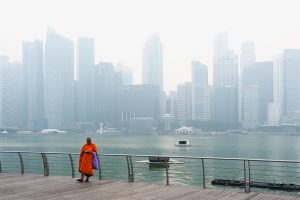Local Pollution as a Determinant of Residential Electricity Demand
September 25, 2022

On 25 September, 2015, the Singapore Ministry of Education ordered all primary and secondary schools to close for one day due to the heavy haze. While many perceive burning at coal-fired power plants to be a major cause of air pollution, the reverse could also be true: air pollution drives up power consumption.
In ‘Local Pollution as a Determinant of Residential Electricity Demand’ (Journal of the Association of Environmental and Resource Economists, 2020), Associate Professor Alberto Salvo (NUS Economics) argues that ambient particle pollution has been a significant and hitherto ignored determinant of energy demand from the residential sector. Overall, residential electricity demand rises by 1.1% when PM2.5 (a kind of air pollution particulate) rises by 10 µg (micrograms) per cubic metre of air. This is because higher PM2.5 induces people to stay indoors more often. When staying indoors, people will also close their windows and use air-conditioners and/or air purifiers (‘defensive behaviour’), either because turning on the air-conditioner makes the stuffy room more comfortable, or households believe that the air-conditioner can filter out the pollutant particulates. This defensive behaviour drives up energy demand and hence greenhouse gas emissions.
To support the postulated relationship between air pollution and electricity demand, A/P Salvo studied monthly electricity and natural gas consumption patterns of a random sample of Singaporean households between September 2012 and December 2015. Focus was put on two severe pollution periods in Singapore, namely the summer of 2013 and the autumn of 2015. During those periods, air pollution caused by the city-state’s own industry, ports, and roads was stable and relatively insignificant compared to that caused by forest fires in Indonesia. The daily mean temperature also varied within a relatively tight range, so people were unlikely to use air-conditioners more often due to hot weather. As such, A/P Salvo rules out the possibility that unobserved energy shocks raised the residential demand for electricity in Singapore, which in turn caused more pollution during these two periods. In any event, Singapore’s low residential share of energy consumption means that any unobserved pollution shocks originating in its residential sector will be small.
A/P Salvo also estimates the impact of pollution on households’ natural gas consumption. His hypothesis is that as people stay at home more often due to air pollution, they will cook more instead of dine out. However, data shows that the impact of pollution on natural gas consumption is less significant than that on electricity demand. While a 10 µg/m3 increase in PM2.5 raises electricity use by about 1%, gas demand increases by only 0.9%. Notwithstanding that, A/P Salvo argues that the data from Singapore shows that air pollution control brings climate co-benefits. Containing air pollution can discourage households’ defensive behaviour and lower their electricity expenditure, which in turn reduces greenhouse gas emissions generated in supplying electricity.
Read the article here: https://doi.org/10.1086/709533
